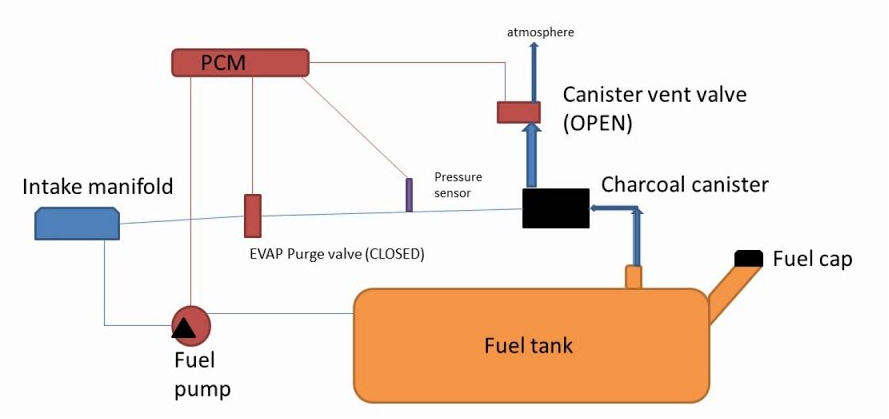You may have never heard of the EVAP system, but you may be interested in the following three issues.
- Why does the fuel gun jump when the tank isn't full?
- The car usually starts normally, but it is difficult to start after refueling at the gas station.
- What will happen to my car if I continue to fill the tank after jumping the gun?
In order to clarify the above issues, you need to have a basic understanding of the EVAP system
What is the an EVAP system, and how does it work?
We all know that gasoline is highly volatile as almost everyone knows exactly how gasoline smells. Evaporative Emission Control (EVAP) System prevents fuel vapors from entering the atmosphere. Vent lines from the fuel tank pass vapors to the vapor canister, where they are trapped and stored until the engine is started. When the engine is warm and the vehicle is going down the road, the PCM then opens a purge valve allowing the vapors to be drawn from the storage canister into the intake manifold. Therefore, EVAP system can not only avoid environmental pollution problems, but also improve fuel efficiency.

A classic EVAP system is usually comprised of fuel tank, gas cap, Leak Detection Pump, fuel tank pressure sensor, Purge valve, EVAP canister, and series of tubes and valves.

The key parts of an EVAP System
EVAP Canister
The EVAP canister is the focal point of the EVAP system, usually filled with activated charcoal, which absorbs and stores gasoline vapors from the gas tank. The vapors are stored in the canister until the engine is being driven. The PCM then opens the canister purge valve, which allows intake vacuum to draw the vapors into the engine. The EVAP canister is connected to the fuel tank through the tank vent line.
Leak Detection Pump (LDP)
The leak detection valve is designed as an outlet installed at the bottom of the charcoal canister (EVAP canister), which can maintain the air pressure balance of the EVAP system, and also prevents the gasoline vapor venting into the atmosphere directly. The entire EVAP system would be completely closed because the leak detection valve, purge valve and tank cap are all closed while the EVAP system is self-monitoring. During this period, the fuel tank pressure sensor detects the positive and negative pressure inside the fuel tank to determine whether there is leakage.
Purge Valve
The purge valve is installed between the intake manifold and charcoal canister, which connected by fuel lines. When the engine reaches the operating temperature, the purge valve opens by the command of PCM. Therefore, the gasoline vapor in the charcoal canister would be sucked into the engine for combustion due to the vacuum negative pressure caused by the intake manifold.
Now we have a general understanding of what the EVAP system is and how it works. Generally speaking, It has three primary operations: storing fuel vapors, purging fuel vapors, and self-monitoring. This seems to provide a reasonable explanation for the three issues at the beginning.
Why does the fuel gun jump when the tank isn't full?
This happens when the leak detection valve gets stuck and stays closed or plugged. Because the leak detection valve is the only air outlet in the EVAP system, if it stays closed or plugged, it will cause the air pressure in the fuel tank to increase as the vapor will not go into the canister, which may cause gun repeatedly jump when refueling.
The car usually starts normally, but it is difficult to start after refueling at the gas station.
This is most likely to happen when the purge valve is broken and stays open. Normally, the purge valve stays closed, and it only opens under some certain conditions. If the purge valve gets stuck and stays open when the car is turned off for refueling, it would cause more gasoline vapor in the fuel tank and EVAP system be delivered into the intake manifold through the open purge valve. As a result, the air-fuel ratio in the combustion chamber is instantly out of balance, the high concentration of gasoline vapor lacks the matching air volume. At this time, it is necessary to apply pressure on your gas pedal to make the throttle valve obtain high airflow to re-balance the air-fuel ratio.
What will happen to my car if I continue to fill the tank after jumping the gun?
Obviously, it would cause the car damage because the EVAP system is only designed to work with vapors, not the liquids. So, when the liquid gas sucked into the EVAP canister through the fuel lines, it makes the charcoal cannot absorb the gasoline vapor any more, which will cause contamination as the liquid gas directly into the environment through the open leak detection pump. Even it can flood the purge valve. which will cause incorrect air-fuel ratios to create more troublesome failures and you have to cost hundreds of dollars to repair.
In fact, there are many other common issues that can be caused by a bad EVAP system. So it’s a good idea to become familiar with the EVAP system and how it works. That way, you’ll have a basic understanding of the system should any problems arise.






